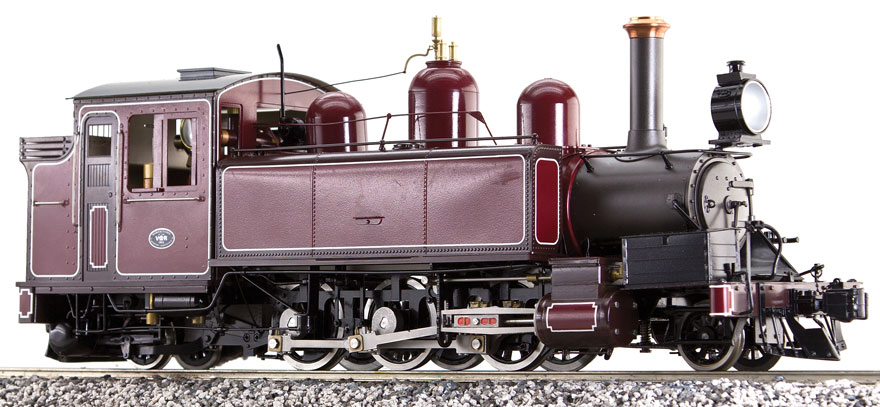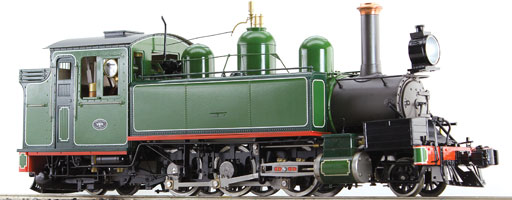| |
 The Victorian Railways (Australia) ‘NA’ class 2-6-2 tank locomotives were built
to serve the 4 narrow gauge 2' 6" (762 mm) gauge branch lines in that state.
Baldwin Locomotive Works in the United States supplied the first two 2-6-2
tank locomotives in 1898 as well as parts for a further two locos. The Victorian
Railways Newport workshops assembled the parts to give an additional two
locos, and subsequently built a further 13 locomotives. The last one, number
17, was built in 1915. The locomotives weigh 36 tons (36.58 t) and produce a
tractive effort of 12,170 lbf (54.1 kN), allowing them to haul loads of 90 tons
(91.44 t) up grades of 1 in 30.
Locomotive 2A
Emile D. Badawy Collection
For an informative and beautifully presented book that covers all four of the
Victorian 2’ 6” Narrow Gauge lines we recommend Nick Anchen’s
‘The Narrow Gauge’ available from Sierra Publishing
http://www.sierraaustralia.com/the-narrow-gauge.html
Two of the original 2’6” narrow gauge lines have been preserved
Puffing Billy Railway
http://www.puffingbilly.com.au/
The 24km (15 miles) of restored line between Belgrave and Gembrook in the
scenic Dandenong Ranges 50 km east of Melbourne. NA class locomotive
numbers 6A, 7A, 8A, 12A, and 14A have been restored and operate on the
‘Puffing Billy’ Steam Railway. No. 3A is also preserved awaiting restoration.
Walhalla Goldfields Railway
http://www.walhallarail.com.au/
In South East Victoria’s Gippsland alpine region the train journeys from the
historic gold mining town of Walhalla and follows Stringer’s Creek to where it
joins the Thomson River, it then crosses the spectacular Thomson River Bridge
to arrive at Thomson Station.
The liveries of the NA class locomotive are a significant historical and aesthetic element of the design. In brief summary, the NA class sported liveries in
the time periods as follows:
98 - 1900 Light Ivy Green and Gold, style 292 of the Baldwin
Locomotive works (1A and 2A only).
1900 - 1903 Victorian Railways Two-Tone Green with white lining
(3A - 6A)
1903 - 1921 Victorian Railways Canadian Pacific Red, Chocolate trim and
white lining (7A-17A)
1921 onward Plain black livery through to preservation in 1953.
Light Ivy Green and Gold
The first two NA class 2-6-2Ts delivered by the Baldwin works in Philadelphia
were painted to a livery standard, known as the Baldwin ‘Book of Styles’.
It was common for US and UK builders to provide new locomotives using
works livery, rather than the specific corporate livery of the purchasing railway
unless specifically requested of the builder. The two Baldwin built NA class
locomotives were delivered in ‘Light Ivy Green and gold, Style 292’ livery. This
was a Baldwin stock export livery of single green finish, lined with gold and red
‘shadow line’. The green paint finish was used extensively on the locomotive,
including the chassis bar frames and cranks. Baldwin’s Ivy Green Style 292
had been extensively used on exports to South America since 1885. It is unknown whether the Victorian railways made any specific requests regarding
the paint and decoration, however this livery would not have looked unusual
in relation to the two tone green scheme then used by the Victorian Railways
as their standard.
VR Two-Tone Green.
The standard Victorian Railways livery of two-tone green with white lining
was applied to the first two NA class built at the Victorian Railways
workshops in 1900. The origin of the two-tone green livery is unknown;
however it probably evolved out of the many two-tone green schemes
provided by UK builders through the 1880s and 1890s. Notably Baldwin
records for other locomotive exports reveal the two-tone green scheme and
white lining to be similar to that used by the Great Central Railway UK at that
time. The Victorian Railways appears to have standardized on this livery
around the mid 1890s and retained the scheme through to 1903. All of the
Victorian built NA class from 1900 and 1901 (3A-6A) were finished with the
scheme and later even the two original Baldwin examples were so painted.
According to the Heritage Manual utilized at the Puffing Billy Railway today,
the two green colours are best matched to British Standard 381c Colours -
B225 Light Brunswick Green and BS227 Dark Brunswick Green. The BS381c
standard dates to 1931 and captures typical pre-mixed paint formula through
the Victorian and Edwardian era, as used in Architecture, railway, carriage
and other transport and agricultural equipment.
The Argyle locomotive Works NA class model depicted in VR two-tone green is
based on the Heritage Manual and BS381c paint standard, reflective of the
locomotive livery from 1900-1903 as well as key locomotives in preservation
today.
VR Candian Pacific Red.
With the appointment of Thomas Tait as Chairman of Commissioners for the
Victorian Railways in 1903 the two-tone green livery was abandoned. Thomas
Tait had come from a successful career with the Canadian Pacific Railroad as
their Assistant General Manager. His time at the Victorian Railways was
relatively short, resigning his commission in 1911 and returning to Canada.
However he left his mark, notably with significant re-organisation of the
Victorian Railways, application of electrification, introduction of the electric
‘Tait’ trains and the application of the ‘Canadian Pacific Red’ on the
locomotive fleet. To be sure, the locomotive fleet was not painted in the
Canadian Pacific Livery; the livery style remained similar in concept to the
previous VR two-tone green scheme, but the greens were replaced with
Canadian Pacific Red and Chocolate Brown. The white line work remained
relatively unchanged.
The Heritage Manuals for the Puffing Billy Railway recommend colour BS540
‘Crimson’ approximating Canadian Pacific Red and BS412 Dark Brown for the
Chocolate brown trim.
The NA class model offered by Argyle Locomotive Works is based on this
Heritage paint advice and the use of the BS381c colours. Of note however is
that the deep red painted NA locomotives of 2013 at Belgrave are painted in
a deep maroon, rather than the British Standard colour advised for CPR red.
The Argyle model more closely reflects the Canadian Pacific Red from the
Puffing Billy Heritage manual which is closer to period examples such as
heritage railway models.
Fade to Black.
The Canadian Pacific Red scheme would remain the standard livery for the VR
from 1903 through to 1921, including the NA class locomotives. Notably all
new NA class built from 7A onward (1905) were out-shopped in this livery,
with all existing NA class repainted shortly after 1903. With the appointment
of Tait’s Prodigy, Harold Clapp, to Chairman of the Victorian Railways
Commissioners in 1919, changes were again made and the locomotive stock
repainted to plain gloss black from around 1921 onward. The plain black
livery would remain in service through to preservation in 1953.
The plain black offering by Argyle Locomotive Works represents the NA class
livery from 1921 onward as well as in preservation.
Specifications
Scale / Gauge
Construction
Mini. Radius
Length
Width
Height
Weight
1:19 / 45 mm
Brass & Stainless Steel
48 in.
17.7 in. (450 mm)
135 in. (135 mm)
180 in. (180 mm)
14.7 lbs
Live Steam
24V DC power
Working couplers
NA-EG
'NA' Class 2-6-2T
Green Livery
Electric
NA-ER
'NA' Class 2-6-2T
Red Livery
Electric
NA-EB
'NA' Class 2-6-2T
Black Livery
Electric
|
|







